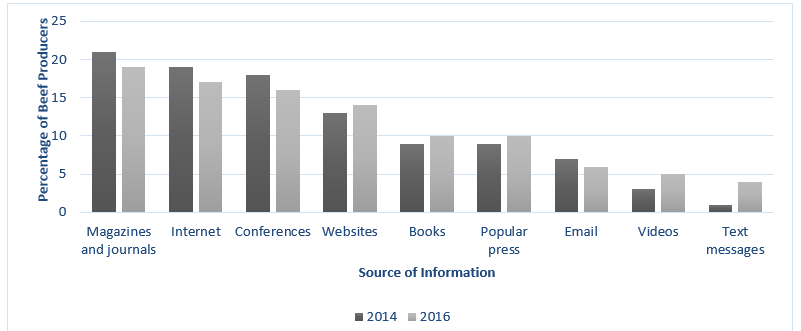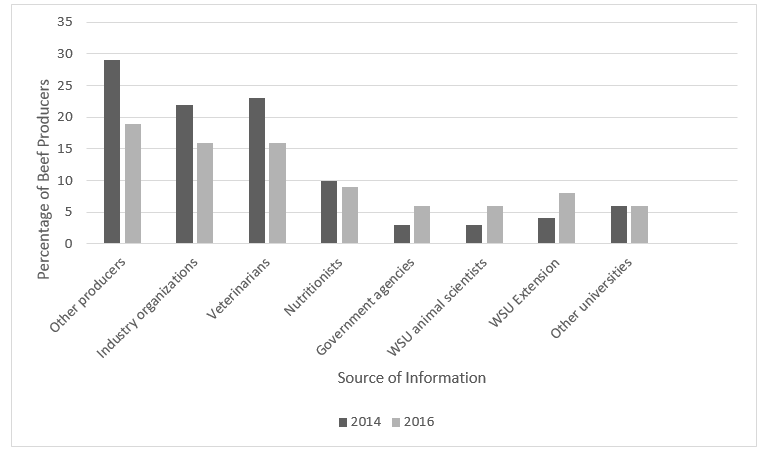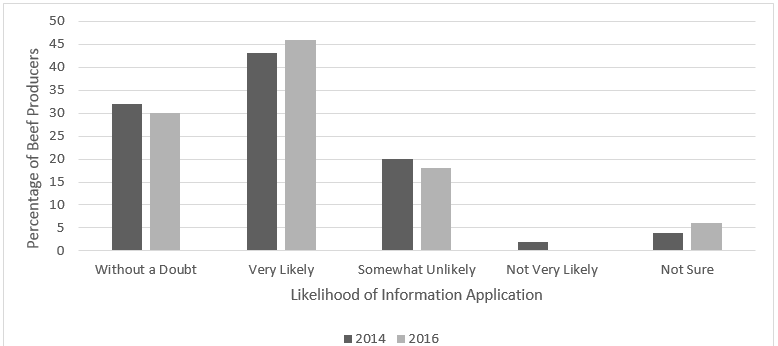 |
June 2018
|
June 2018 // Volume 56 // Number 3 // Research In Brief // v56-3rb2
Do Beef Production Conferences Affect Beef Producers' Perceptions of Applied Research and Extension Programs?
Abstract
Decreased visibility and awareness of what Washington State University (WSU) was doing for the beef industry was a critical issue raised by beef industry leaders and WSU faculty. Statewide conferences have been used to distribute information to beef producers. However, these conferences require large commitments of labor, time, and financial resources, and it was not known whether they are effective given that so much information is easily obtained electronically. Therefore, we surveyed beef producers at WSU Beef Production Conferences in 2014 and 2016. Recommendations for improving translation of information include maintaining beef conferences, publishing more articles in beef trade magazines, and increasing information on WSU Internet sites. Applying similar activities elsewhere and with other agricultural producer audiences may prove useful.
Introduction
Through the 1980s, Washington State University (WSU) conducted annual Beef Information Days on the WSU campus as a major outreach and education effort to serve the state's beef producers. At these events, many beef industry leaders received the results of WSU Department of Animal Science beef research. In the 1990s, when the event was conducted off campus at various locations, attendance began to decline, and the event was discontinued after 2005. Similarly, according to Warner, Christenson, Dillman, & Salant (1996), use of Extension declined from 1982 to 1995 for most program areas. Additionally, Schafer (2006) assessed perceptions of University of Wyoming Extension Service livestock programming by livestock producers and concluded that 42% of participating producers had not used the University of Wyoming Extension Service livestock program. Two anecdotal reasons for the reduction in attendance at WSU Beef events were that producers felt the location (WSU campus) was not convenient and that the information presented was less and less relevant to the state's beef producers.
In the 2010s, WSU Extension went through a reorganization from a geographical district-based structure to a programmatic/disciplinary-based one. Because of the change in structure, there has been greater communication and collaboration among the WSU research and Extension faculty working on livestock-related programs. This interaction revealed a shared concern that decreased awareness among members of the state's beef industry regarding WSU's efforts for the industry was a critical issue. A return to hosting statewide conferences occurred during this time. However, major statewide conferences involve large commitments of labor, time, and financial resources. If such programs are to continue, they need to be relevant in a world in which so much information is easily obtained electronically. Although technology may have increased importance in the future (Mirando et al., 2012), Dahlen, Hadrich, and Lardy concluded in 2014 that the use of traditional methods are needed to satisfy existing Extension clientele. Since the development of an instrument to measure quality of Extension output by Young and Cunningham (1977), many clientele perception studies have occurred (e.g., Decker & Yerka, 1990; Radhakrishna, 2002); however, WSU had not conducted any such studies. Therefore, at major beef production conferences WSU held in 2014 and 2016, we conducted pre- and postconference surveys to explore producers' awareness of the WSU beef cattle research and Extension programs and their preferences related to obtaining beef production information.
Methods
The June 2014 WSU Beef Production Conference was held at Yakima, Washington, consisted of 18 sessions conducted as concurrent sessions on a Friday and Saturday, and was titled "Tools and Techniques for the Future." In addition to the educational programs, the conference featured a major beef industry trade show with 36 vendor booths set up by private companies and various other organizations serving the Washington beef industry. Total attendance at the conference was 179, with 102 attendees identifying themselves as beef producers. The April 2016 WSU Beef Production Conference was held at Pasco, Washington, and involved a Friday evening session (four presentations) titled "Post Fire Techniques, Tools and Strategies for Beef Producers" and a Saturday session (10 presentations) titled "Tools and Techniques for Beef Production." At the 2016 conference, there was not a trade show, total attendance was 88, and 60 attendees identified themselves as beef producers. Other attendees each year identified themselves as university faculty or employees of allied industries or other organizations (30% in 2014, 39% in 2016) and students (13% in 2014, 5% in 2016). Each year, we conducted pre- and postconference surveys of beef producers in attendance, using Turning Point software (Turning Technologies, Youngstown, OH), to identify their perceptions of the WSU beef cattle research and Extension programs, preferred methods for obtaining information about beef production, and preferred sources of information to use for decision making.
Results and Discussion
Interestingly, different beef producers attended the two conferences. Across the conferences, distributions of beef producers who answered the question of how many years they had raised cattle were bimodal. Proportions of producers in business less than 10 years and over 20 years each averaged 40% (data not shown). In response to the preconference surveys at both the 2014 and 2016 events, large percentages of attending beef producers could not rate the quality of WSU's research programs (54% and 43%, respectively) or Extension programs (37% and 36%, respectively) (Table 1); these results are similar to findings by Schafer (2006).
| 2014 | 2016 | |||
| Quality rating | Research | Extension | Research | Extension |
| Excellent | 8% | 15% | 14% | 15% |
| Good | 23% | 35% | 31% | 30% |
| Fair | 12% | 8% | 10% | 15% |
| Poor | 3% | 5% | 2% | 4% |
| Don't know | 54% | 37% | 43% | 36% |
Preferred methods for receiving information about beef production were almost the same across the two survey years (Figure 1), with the most important methods being reading magazines and journals, conducting Internet searches, and attending conferences. Schafer (2006) suggested that younger beef producers were more comfortable with Internet searches and that older producers preferred Extension's traditional methods of delivery of conferences and printed material. It appears that the demographics of our audiences may explain the almost equal scores for conducting Internet searches and attending conferences. In contrast, studies in Florida (Vergot, Israel, & Mayo, 2005) and North Dakota (Dahlen et al., 2014) identified newsletters and bulletins as the preferred method of information retrieval and Internet searches as the least preferred method. With regard to sources of information used for decision making by the beef producers we studied, the top three preferred sources were other producers, beef industry organizations, and veterinarians (Figure 2).
Figure 1.
Methods for Obtaining Information Preferred by Beef Producers Surveyed at Washington State University Beef Production Conferences

Figure 2.
Sources of Information Used for Decision Making Preferred by Beef Producers Surveyed at Washington State University (WSU) Beef Production Conferences

Postconference surveys showed large improvements in producers' perceptions of the quality of WSU beef cattle research and Extension programs (Table 2). Unlike with the preconference survey both years, only small percentages of attendees reported not knowing about the programs. Additionally, the percentages of respondents who reported that the research and Extension programs were good or excellent increased to between 73% and 90%, indicating that these face-to-face conferences were successful in improving perceptions of WSU beef cattle research and Extension programs. Finally, at least 75% of beef producers were very likely or without a doubt going to apply information learned at the conferences to their operations (Figure 3).
| 2014 | 2016 | |||
| Quality rating | Research | Extension | Research | Extension |
| Excellent | 31% | 33% | 28% | 25% |
| Good | 49% | 40% | 62% | 53% |
| Fair | 11% | 19% | 10% | 12% |
| Poor | 6% | 3% | 0% | 2% |
| Don't know | 3% | 5% | 0% | 8% |
Figure 3.
Beef Producers' Likelihood of Applying Information from the 2014 and 2016 Washington State University Beef Production Conferences

Conclusions and Recommendations for Extension Programming
Based on the results of our surveys, WSU should maintain beef production conferences. They meet needs across the distribution of beef producers. Further, WSU should increase publication of articles on translational research in beef trade magazines and journals to serve the educational needs of younger beef producers. Finally, Internet sites at WSU should contain more translational research information.
These recommendations may be applicable to other locations and agricultural producers as well. For example, other states may have higher numbers of beginning farmers than Washington State (ranked eighth) or have higher numbers of second and third operators who have fewer years in production agriculture (U.S. Department of Agriculture National Agricultural Statistics Service, 2012). These demographics could result in a bimodal distribution of years in production agriculture resulting in equal need for conferences and the Internet as preferred methods for producers to obtain educational materials.
References
Dahlen, C. R., Hadrich, J. C., & Lardy, G. P. (2014) The North Dakota Beef Industry Survey: Implications for Extension. Journal of Extension, 52(6), Article 6RIB7. Available at: http://www.joe.org/joe/2014december/rb7.php
Decker, D., & Yerka, B. (1990). Organizational philosophy for program evaluation. Journal of Extension, 28(2), Article 2FRM1. Available at: http://www.joe.org/joe/1990summer/f1.html
Mirando, M. A., Bewley, J. M., Blue, J., Amaral-Phillips, D. M., Corriher, V. A., Whitter, K. M., . . . Patterson, D. J. (2012). Extension education symposium: Reinventing Extension as a resource—What does the future hold? Journal of Animal Science , 90(10), 3677–3692.
Radhakrishna, R. (2002). Measuring and benchmarking customer satisfaction: Implications for organizational and stakeholder accountability. Journal of Extension, 40(1), Article 1RIB2. Available at: http://www.joe.org/joe/2002february/rb2.html
Schafer, S. R. (2006). Clientele perceptions of the University of Wyoming Cooperative Extension Service livestock program. Journal of Extension, 44(2), Article 2RIB6. Available at: http://www.joe.org/joe/2006april/rb6.php
U.S. Department of Agriculture National Agricultural Statistics Service. (2012). Retrieved from https://www.agcensus.usda.gov/
Vergot, P., Israel, G., & Mayo, D. E. (2005). Sources and channels of information used by beef cattle producers in 12 counties of the northwest Florida Extension district. Journal of Extension, 43(2), Article 2RIB6. Available at: http://www.joe.org/joe/2005april/rb6.php
Warner, P. D., Christenson, J. A., Dillman, D. A., & Salant, P. (1996). Public perception of Extension. Journal of Extension, 34(4), Article 4FEA1. Available at: http://www.joe.org/joe/1996august/a1.php
Young, R. E., & Cunningham, C. J. (1977). Extension output measures as identified by Extension clientele. Columbus, OH: The Ohio State University. Retrieved from http://files.eric.ed.gov/fulltext/ED152982.pdf




